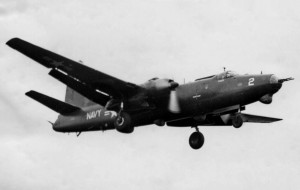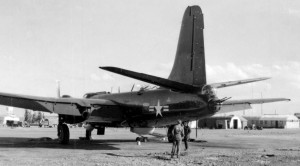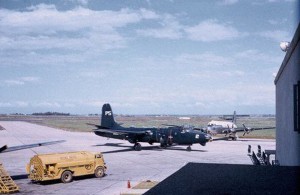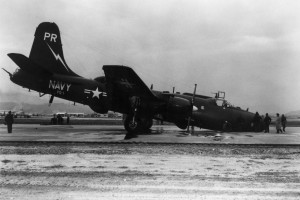Published on June 16, 2013
By Thomas C. Van Hare
The day had begun normally with a morning preflight of the Martin P4M-1Q Mercator aircraft. The mission was a standard one for the US Navy’s Fleet Air Reconaissance Squadron ONE (VQ-1), known as the “Batmen” — they were a signals intelligence specialist unit based in Japan. As always, such reconnaissance/intelligence missions carried some level of risk, but this one was a regular flight on a well-practiced route. Nonetheless, other aircraft had been ambushed by fighters on the same mission, once with deadly consequences when another of VQ-1’s Mercators had been downed by the Red Chinese off the coast by Shanghai on August 22, 1956. That day, the full crew of 16 were killed. Such missions were worth the risks, however, as they collected valuable signals intelligence data on North Korean radar systems and other communications — signals that would be essential if the conflict on the Korean peninsula were to restart.
The June 16, 1959, mission was similar — and this time, as had happened three years earlier, suddenly, a pair of MiG-17 jet fighters were spotted closing in from the east. The two Navy pilots pushed the nose of the P4M-1Q Mercator over and dove quickly toward the water. This was a standard technique designed to escape below the horizon of the land-based, coastal radar systems 30 miles away operated by the North Korean ground controllers. The MiG-17 “Fresco” jet fighters, however, had already spotted the Mercator. Once in pursuit, the slower, larger and less maneuverable Navy plane was an easy target. As the American crew tried to make a run toward Japan, the two MiG-17s came in range and opened fire.

The Aircraft and Mission
The Martin P4M-1Q Mercator was a mid-sized, very specialized aircraft. The aircraft had two propellers, but four engines — two were turbine jets running regular gasoline, available to provide extra power for take off and high speed dash as a supplement to the longer range afforded by the more fuel efficient, P&W R4360 Wasp Major 28-cylinder radial engines, each of which produced 3,250 hp. Originally, the Mercator had been designed in hopes of winning the contract to replace the US Navy’s former PB4Y Privateer patrol bomber. Sadly, the Martin design lost the bid to the Lockheed P2V Neptune. While the Neptune went on to a long and illustrious career with the US Navy, nonetheless, the senior Navy brass had still other uses for the P4M-1Q. A small order for the aircraft was quietly placed. By mid-1953, at the height of the Korean War and in the early days of the expanding Cold War, these specialized Martin P4M-1Q Mercators were assigned to operate with the US Navy’s secretive VQ-1, charged with intelligence gathering on clandestine midnight flights down the coasts of America’s Cold War adversary nations.
VQ-1 had been formed to support long range signals intelligence (SIGINT) operations during the Korean War. Originally based out of the Philippines, it had moved over the years to Japan and was based by 1959 at Iwakuni. Initially, the planes were crewed by 14 men, though this was later expanded to 16 as the requirements expanded. By 1959, the P4M-1Q Mercators assigned to the unit were bristling with antennae of all different types and housing various odd-shaped bulges on the fuselage where radar collectors were mounted. The typical VQ-1 mission would fly across the Sea of Japan and turn to make a track along the coast of North Korea up along China’s coasts, usually staying about 30 miles offshore and at about 7,000 feet of altitude. To disguise the mission, the P4M-1Q Mercators would use call signs of regular P2V Neptune patrol flights. Indeed, from a distance the planes even looked enough alike that it was a reasonable ruse — markings and BuNo codes would be painted out or falsified to further camouflage the mission and aircraft’s purposes.

A Deadly Chase
The VQ-1 mission of June 16, 1959, took place over the Sea of Japan and ran down the coast of North Korea at the usual altitude of 7,000 feet. What started as a regular flight surveying enemy signals, however, changed abruptly into a deadly chase when two North Korean MiG-17s intercepted the plane. At the controls of the P4M-1Q Mercator were LCDR Donald Mayer, the aircraft commander, and LCDR Vince Anania, a former All-American college football player at the US Naval Academy in Annapolis, who was serving as copilot. Besides the intelligence contingent, the tail gunner on the Navy crew was PO2/c Eugene Corder.
As the two MiG-17s curved in to make a high speed firing pass, PO2/c Corder manned the P4M-1Q’s tail armament, a pair of 20mm cannons. The MiG-17s, however, closed rapidly and showed astonishingly good aim on their first pass. PO2/c Corder never had a chance to defend the plane as the first attack scored extensive hits across the Mercator’s fuselage and wing. PO2/c Corder was hit badly, suffering injury from over 40 pieces of shrapnel that left him incapacitated. As the P4M-1Q Mercator reached an altitude of 50 feet, its propellers turning on the power of all four engines, it reached a speed of more than 350 mph. While fast for a propeller aircraft, however, this was no match for the MiG-17.

The MiGs came around for attack after attack, making yet more firing passes on the crippled plane. The engines on the right wing were both hit. The rudder was knocked out. As the MiG-17s fired their cannons on pass after pass, the plane was badly damaged and barely holding together. The controls, being mechanical, seemed ill-suited to counteract the imbalance from the damage done and asymmetric thrust of the left side engines, which were turning at maximum power. The plane started to roll over, yet LCDR Anania was not going to go down without a fight. With brute strength alone — the kind that only being an All-American football star could bring — he fought the controls and wrestled the plane back level. As they sped toward Japan, it took all the strength he had to hold the plane upright. Despite the pain and stress, he held it in a near superhuman grip.
Yet the Mercator was hopelessly outclassed by the two MiG-17s. It was unarmed and it seemed that the only hope for the plane and the Navy crewmen might be to somehow get far enough away from the coast of North Korea that the two MiG pilots would have sufficient fuel to make it back to their bases. They would have to turn for home. Six more firing passes were completed after that first deadly attack on the P4M-1Q Mercator as it sped along just a few dozen feet from the tops of the waves. Unable to make diving passes from above to below, lest they impact the water, the MiGs had to break off each firing pass and circle back higher up before coming around for another attack. Finally, they had reached minimum fuel. With a final firing pass, they turned west and flew back to their base in North Korea.
The Martin P4M-1Q Mercator had somehow survived — against all odds. Its fuselage was holed. The rudder was shot away. Both right engines were destroyed. The wing was peppered with cannon rounds. Yet it still flew. The attack, which had started 30 miles off the coast, had been a running 20 mile long death-defying race against what should have been the inevitable destruction of the plane and death of the crew. As the MiGs turned away, however, there was hope. Yet the Mercator’s crew knew that with the extensive damage sustained, it was still an open question as to whether they would survive the flight back to Japan.

Aftermath
Somehow, LCDRs Mayer and Anania held the badly damaged Mercator off the water as they closed on the coast of Japan. Ahead was Miho, a heavy maintenance base used primarily by the US Military. The base’s name was easy to remember because of the colloquial rhyme that was commonly spoken among aircrews, “Miho by the Sea-Ho”. For many, Miho was a favored destination to take a plane from South Korea for regular maintenance. While in Japan, the flight crews would hoof it to Tokyo for a little approved “R&R”. That day, Miho was not about R&R — it meant salvation for the Navy crew.
Incredibly, Anania and Mayer brought the badly damaged Mercator down onto the runway for an emergency landing. Once the plane had skidded to a stop, the men leapt out and moved clear. Incredibly, only PO2/c Corder was injured, though he would survive and heal. The resto of the men had come through the attacks unscathed. The data collected was retrievable, though none of it was anything but routine confirmation of the SIGINT environment in which the conflict was an ongoing affair. PO2/c Corder was subsequently issued a Purple Heart and an Air Medal for his role in defending the aircraft in the attacks. In fact, all of the crew earned Air Medals, while LCDRs Mayer and Anania both were awarded the Distinguished Flying Cross for their incredible feat of keeping the plane aloft long enough to make a successful emergency landing at Miho, where the crew no doubt spent some well-earned R&R time.

As for the P4M-1Q Mercator involved that day in the conflict (BuNo 122209), it was written off as irreparable. Less than a year later, VQ-1 retired all of its remaining P4M-1Q Mercators, converting entirely to the Douglas A3D-2Q Skywarriors, a twin-engined jet reconnaissance aircraft that offered better speed and survivability. Even that, however, would prove to be just another step in the increasingly deadly game of Cold War reconnaissance. The interception of the P4M-1Q Mercator that day was the 33rd attack over the last decade on US reconnaissance planes of all types. The Martin P4M-1Q Mercator had done nearly a decade’s service in the secret, very hot war of the reconnaissance crews who daily risked their lives in the darkest days of the Cold War.

Today’s Aviation Trivia Question
Just one question remains to be resolved as of this date — were the North Korean MiG-17s were really piloted by North Koreans or were they flown by Russian “honchos”? The Soviet Union had a tradition of flying in North Korean colors during the Korean War and beyond on critical important missions against the USA

You don’t mention the Super Constellations that came on line after the P4M. The WV-2/EC-121 flew for many years after to be replaced by EP-3s, the first one coming on line in mid-1969. Also, you don’t mention the EC-121 shoot down by the North Koreans in 1969. The story would read pretty much the same as for this P4M, except the Connie splashed down some 90 miles of the North Korean coast. That was my crew and they were lost just four days after I left the squadron.
The story of the WV-2/EC-121 shoot down by the North Koreans in 1969 is told in another story here at Historic Wings, called “Beggar Shadow Down” — http://fly.historicwings.com/2013/04/beggar-shadow-down/ — and your input as one who knew the men on that flight, would be most helpful to further fill out the story for the readers.
You do not mention the 1956 P4M-1Q running gunbattle with two MIG -17s in the Taiwan Straights. It all ended well. Aircraft Commander was LCDR Sy Worsley.
I was the pilot of 124362 in the Spring of 1955 when we were attacked about 10 miles off Tsing Tau by two MiGs. It was a dark, clear night and we were close enough to the airport to observe them take off and come straight at us. We did a power off tight spiral to 300 feet while they fired 30 mm shells over the cockpit. Our tail gunner fired several hunred rounds in return. We kept turning under the MiGs and they appeared to lose track of us and we departed at max speed, which was 385 kts.
At the time, the Chinese were training in the MiGs so that might explain their inability to press the attack. My aircraft, 124362, was later downed by the Chinese in 1956. I left the squadron a few months before that happened and most of those lost were my crew. At that time, during those types of missions, we flew 10 miles off the coast.
I was an enlisted crewman, radio, on the first deployment of the P4M-1Q to the Philippines in late 1951. Bureau No. 121453. I took part in ninety five patrols during a two year period. l left the Navy in 1954 to do other things and didn’t give a lot of thought to those Navy years until recently.
I used the GI bill to get an Electrical Engineering degree, retired at 63, and worked in real estate for another ten years, and then started writing novels. About four years ago I put together a short story with the title, “US Navel Air Routine Patrol.” It is fiction describing a patrol which included a number of interesting things that occurred during the time I was part of the Philippine detachment. The story gives an enlisted persons perspective to a navy patrol mission. It has been published in e-book form and is available on Amazon.
I have decided to update the short story and make it available in print form. In order to do that, I need to add five more pages to make it eligible to be produced in printed form. I have decided to include, with author permission, supplements to the current short story with articles and descriptions of actual incidents such as the one in this article. While doing this, I have found I need to refresh my memory which has forgotten many of the details of these activities.
Approved and good luck with your project!